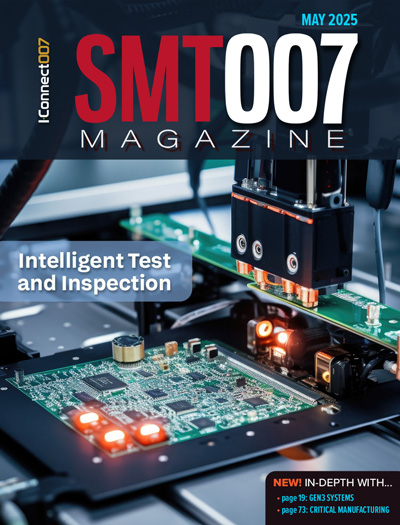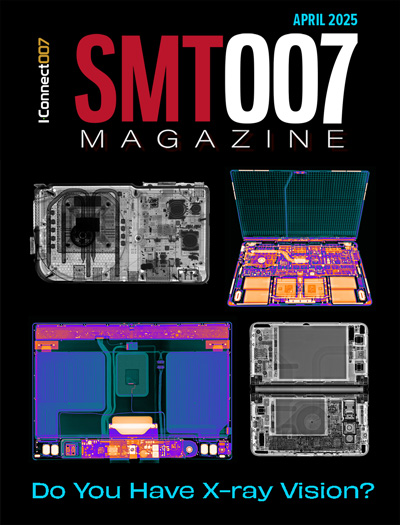-

- News
- Books
Featured Books
- smt007 Magazine
Latest Issues
Current Issue
Moving Forward With Confidence
In this issue, we focus on sales and quoting, workforce training, new IPC leadership in the U.S. and Canada, the effects of tariffs, CFX standards, and much more—all designed to provide perspective as you move through the cloud bank of today's shifting economic market.

Intelligent Test and Inspection
Are you ready to explore the cutting-edge advancements shaping the electronics manufacturing industry? The May 2025 issue of SMT007 Magazine is packed with insights, innovations, and expert perspectives that you won’t want to miss.

Do You Have X-ray Vision?
Has X-ray’s time finally come in electronics manufacturing? Join us in this issue of SMT007 Magazine, where we answer this question and others to bring more efficiency to your bottom line.
- Articles
- Columns
- Links
- Media kit
||| MENU - smt007 Magazine
Untapped Potential: Automating Warehouse Management Into the Present
October 15, 2024 | Josh Casper, Horizon SalesEstimated reading time: 2 minutes
The push toward automation in electronics manufacturing has led to significant improvements in SMT and through-hole technology (THT) production. Today’s manufacturers are outfitted with precision pick-and-place machines, sophisticated inspection systems, and advanced solder deposition solutions. These investments reflect a broader industry trend toward automating high-value production tasks to boost efficiency, improve quality, and reduce headcount in a shrinking labor market. While the spotlight has rightly focused on automating SMT production, one crucial area remains woefully under-invested: materials storage and handling.
This oversight is particularly concerning given the critical role that materials management plays in the overall manufacturing process. Materials—such as SMT/THT components, bare boards, and solder paste—are the lifeblood of production. How they are stored, tracked, and deployed directly impacts the effectiveness of the entire operation. Here, we’ll explore the impact of material handling and how automating this area can significantly enhance productivity, reduce costs, and ensure quality in electronics manufacturing.
The Impact of Manual Materials Handling
Manual materials handling remains a significant bottleneck in many electronics manufacturing facilities. In traditional setups, components are stored on shelves or in bins, with warehouse employees responsible for manually retrieving and deploying them to the production line. This manual process leads to myriad issues.
First, manual component kitting is one of the more labor-intensive areas of the facility. Operators are tasked with manually moving from location to location and retrieving one part at a time. For argument’s sake, if an operator can pick a single part every minute (and that’s being very aggressive), a smaller 60-piece kit would take at least an hour to pick. Now, multiply that across all the jobs and a manufacturer could be pulling in a single eight-hour shift. How many employees are dedicated to just pulling and returning materials? The time spent locating and moving materials slows down the production process, significantly negating the benefits of advanced automation on the SMT line.
Another common issue in manual picking is component misplacement. When reels are stored on shelves and tied to a manual location, it is entirely dependent upon the operator to ensure they’re not only pulling the correct part, but also returning it to the correct location. It’s human nature to make these mistakes, but they can easily compound, leading to line stoppages due to a single missing component. Worse yet, having the automated placement equipment placing the wrong component on multiple PCBs creates re-work havoc because it was incorrectly put in a kit by the manual picking operation.
Manual handling often leads to inventory inaccuracies as well. Without real-time tracking and automated management, it’s easy for inventory levels to become misaligned with actual stock. This can result in overstocking, which ties up valuable space and capital, or stock outages, which can halt production and lead to costly emergency ordering. Component visibility is critical, especially in a world where component availability leaves much to be desired.
To read the rest of this article, which appeared in the October 2024 issue of SMT007 Magazine, click here.
Suggested Items
Specially Developed for Laser Plastic Welding from LPKF
06/25/2025 | LPKFLPKF introduces TherMoPro, a thermographic analysis system specifically developed for laser plastic welding that transforms thermal data into concrete actionable insights. Through automated capture, evaluation, and interpretation of surface temperature patterns immediately after welding, the system provides unprecedented process transparency that correlates with product joining quality and long-term product stability.
Excellon Installs COBRA Hybrid Laser at Innovative Circuits
06/23/2025 | ExcellonExcellon is pleased to announce the successful installation of a second COBRA Hybrid Laser System at Innovative Circuits, located in Alpharetta, Georgia. The Excellon COBRA Hybrid Laser System uniquely combines both UV and CO₂ (IR) laser sources on a single platform—making it ideal for high-density prototype and production printed circuit boards (PCBs).
Smart Automation: The Power of Data Integration in Electronics Manufacturing
06/24/2025 | Josh Casper -- Column: Smart AutomationAs EMS companies adopt automation, machine data collection and integration are among the biggest challenges. It’s now commonplace for equipment to collect and output vast amounts of data, sometimes more than a manufacturer knows what to do with. While many OEM equipment vendors offer full-line solutions, most EMS companies still take a vendor-agnostic approach, selecting the equipment companies that best serve their needs rather than a single-vendor solution.
OKI, NTT Innovative Devices Establish Mass Production Technology for High-Power Terahertz Devices by Heterogeneous Material Bonding
06/21/2025 | BUSINESS WIREOKI, in collaboration with NTT Innovative Devices Corporation, has established mass production technology for high-power terahertz devices using crystal film bonding (CFB) technology for heterogeneous material bonding to bond indium phosphide (InP)-based uni-traveling carrier photodiodes (UTC-PD) onto silicon carbide (SiC) with excellent heat dissipation characteristics for improved bonding yields.
Sierra Circuits Boosts High Precision PCB Manufacturing with Schmoll Technology
06/16/2025 | Schmoll MaschinenSierra Circuits has seen increased success in production of multilayer HDI boards and high-speed signal architectures through the integration of a range of Schmoll Maschinen systems. The company’s current setup includes four MXY-6 drilling machines, two LM2 routing models, and a semi-automatic Optiflex II innerlayer punch.


